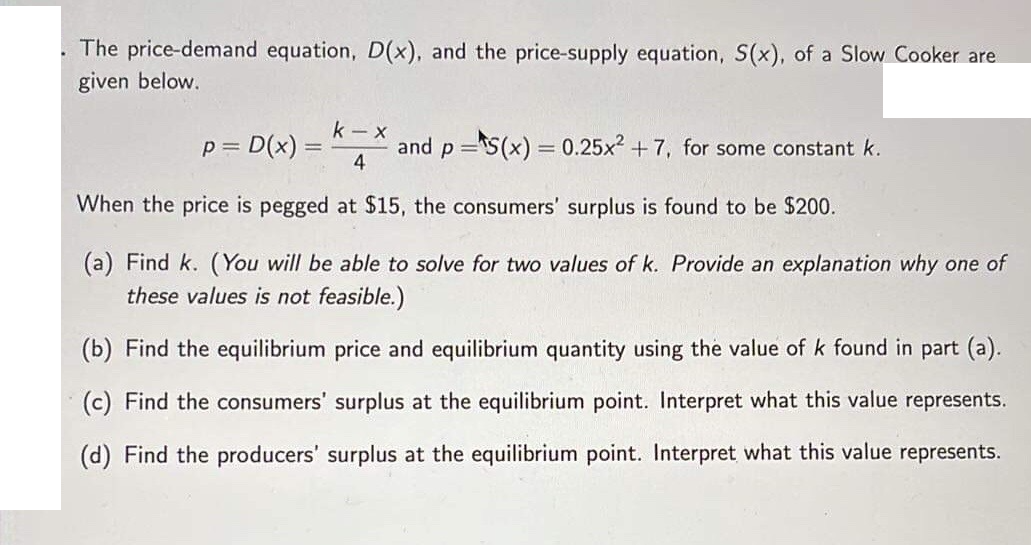The price-demand equation, D(x), and the price-supply equation, S(x), of a Slow Cooker are given below. k - x P = D(x) = and p =s(x) = 0.25x2 +7, for some constant k. 4 %3D %3D When the price is pegged at $15, the consumers' surplus is found to be $200. (a) Find k. (You will be able to solve for two values of k. Provide an explanation why one of these values is not feasible.) (b) Find the equilibrium price and equilibrium quantity using the value of k found in part (a). (c) Find the consumers' surplus at the equilibrium point. Interpret what this value represents. (d) Find the producers' surplus at the equilibrium point. Interpret what this value represents.
The price-demand equation, D(x), and the price-supply equation, S(x), of a Slow Cooker are given below. k - x P = D(x) = and p =s(x) = 0.25x2 +7, for some constant k. 4 %3D %3D When the price is pegged at $15, the consumers' surplus is found to be $200. (a) Find k. (You will be able to solve for two values of k. Provide an explanation why one of these values is not feasible.) (b) Find the equilibrium price and equilibrium quantity using the value of k found in part (a). (c) Find the consumers' surplus at the equilibrium point. Interpret what this value represents. (d) Find the producers' surplus at the equilibrium point. Interpret what this value represents.
Chapter29: Resource Markets
Section: Chapter Questions
Problem 4E
Related questions
Question

Transcribed Image Text:The price-demand equation, D(x), and the price-supply equation, S(x), of a Slow Cooker are
given below.
k - x
p = D(x) =
and p =s(x) = 0.25x2 + 7, for some constant k.
4
%3D
When the price is pegged at $15, the consumers' surplus is found to be $200.
(a) Find k. (You will be able to solve for two values of k. Provide an explanation why one of
these values is not feasible.)
(b) Find the equilibrium price and equilibrium quantity using the value of k found in part (a).
(c) Find the consumers' surplus at the equilibrium point. Interpret what this value represents.
(d) Find the producers' surplus at the equilibrium point. Interpret what this value represents.
Expert Solution
This question has been solved!
Explore an expertly crafted, step-by-step solution for a thorough understanding of key concepts.
This is a popular solution!
Trending now
This is a popular solution!
Step by step
Solved in 2 steps

Knowledge Booster
Learn more about
Need a deep-dive on the concept behind this application? Look no further. Learn more about this topic, economics and related others by exploring similar questions and additional content below.Recommended textbooks for you

